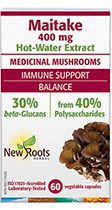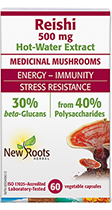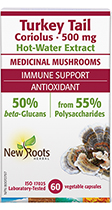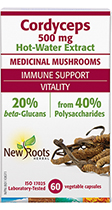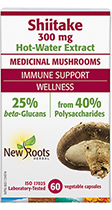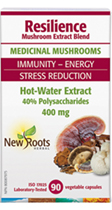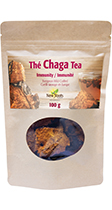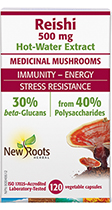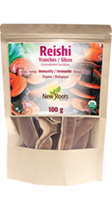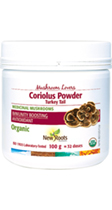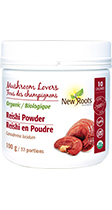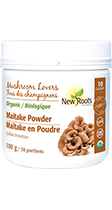Fabulous Fungi: The Immune Effects of Medicinal Mushrooms
With cold-and-flu season in full swing, it’s essential to have an array of tools to support your immune system. Edible medicinal mushrooms have been traditionally used for health promotion and longevity in East Asian countries for centuries. The polysaccharides (complex carbohydrates) found in these fungi possess an array of health-promoting properties such as immunomodulation, antitumour, antiaging, and antioxidant effects.[1] Before we take a deeper dive into the various species of medicinal mushrooms and their immune effects, you must first be assured that your medicinal mushrooms have been prepared in such a way as to provide you with the greatest health benefits. You see, the structure of mushrooms, unless properly prepared, renders these polysaccharides and their immune supportive effects inaccessible to us.
The immune effects of medicinal mushrooms are attributed to the presence of polysaccharides known as beta-glucans (β-glucans). Without proper preparation, these β-glucans are inaccessible as they are found embedded in the mushroom’s cell walls, which are made from an incredibly tough, indigestible fibre known as chitin.[2] Chitin is the same substance from which the shells of crustaceans are made of, which—for those of you who have not tried to eat a lobster shell—is incredibly difficult to break down.
Hot-water extraction (as a tea or decoction) is the traditional preparation of medicinal mushrooms and the only clinically validated method for breaking these polysaccharides out of the indigestible cell walls.[3]
Why hot-water extraction? Hot-water extraction dissolves chitin, and once the water (and chitin) is removed, the β-glucans are liberated and able to exert their health effects, which can be amplified through concentration.[4]
Once your medicinal mushrooms have undergone hot-water extraction, the question is: Which mushroom to choose? Let’s take a closer look at the most common medicinal mushrooms and their immune effects.
Shiitake (Lentinula edodes)
Shiitake is a culinary medicinal mushroom with its origins in Asian cuisine.[5] Rich in lentinan, a β-glucan, shiitake has shown the ability to modulate the immune system—through affecting T cells, a category of cells important to fight viral infections and cancer. Lentinan was shown to reduce allergic reactions, to have anticancer effects, and to improve health outcomes in people with HIV.[6], [7] The anticancer effects of shiitake appear to be the result of accelerating the rate of cell death (known as apoptosis) in breast cancer as well as myeloma (bone-marrow cancer).[8] Shiitake has also been shown to reduce inflammation and to upregulate secretory immunoglobulin A (IgA), therefore improving the immune function in the digestive tract. It also appears to modify the composition of the gut microbiome—a major site for our immune system.[9], [10]
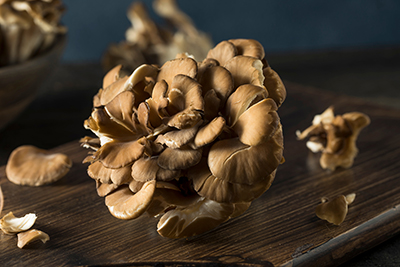 Maitake (Grifola frondosa)
Maitake (Grifola frondosa)
Maitake’s main immune-modifying effects have been attributed to β-1,3-glucan and β-1,6-glucan. These have been shown to enhance the functioning of several different categories of immune cells, including macrophages as well as T and NK cells, and to augment antibody production.[11], [12], [13], [14] Through increasing T- and NK-cell numbers, maitake has demonstrated anticancer effects in patients with lung, liver, and breast cancers.[15] Additionally, maitake is showing promising results in its anticancer effects against prostate cancer, by increasing the rate of cell death for prostate-cancer cells.[16] And much like shiitake, maitake has also demonstrated improved health outcomes in the form of a raised CD4+ (aka T-helper cells that contribute directly to viral clearance, among other functions) count for people diagnosed with HIV.[17]
Chaga (Inonotus obliquus)
Chaga is a parasitic fungus that grows commonly on birch trees. Chaga’s main immune-supporting effects are due to the presence of both β-glucans and botulin.[18] Hot-water extracts of chaga have been shown to reduce markers of inflammation including TNF-α that are implicated in a variety of autoimmune conditions.[19] Chaga has been shown to increase production of immune cells—including macrophages, eosinophils, neutrophils, and basophils—that were suppressed from chemotherapy.[20] Aside from improving immune health among the immunocompromised, chaga has shown antiviral effects against a range of viruses including herpes simplex virus-1 (HSV-1) by preventing it from fusing with and infecting host cells.[21], [22] Additional antiviral effects have been demonstrated against HPV as well as HIV.[23], [24] Like its fellow medicinal mushrooms, chaga was also shown to slow the growth of colon-, breast-, lung-, and brain-cancer cells.[25], [26], [27], [28], [29]
Reishi (Ganoderma lucidum)
Reishi—the Japanese word for “mushroom of immortality”—has a long history of use for immune support.[30] Reishi, like other medicinal mushrooms, is well known for its antiviral and antitumour effects. Through increasing activity of tumour-suppressing NK and T cells, reishi has shown positive outcomes in the treatment of breast, lung, and colorectal cancers.[31], [32], [33], [34], [35], [36] Its antiviral effects have been demonstrated most clearly in the accelerated relief in symptoms of recurring genital herpes.[37]
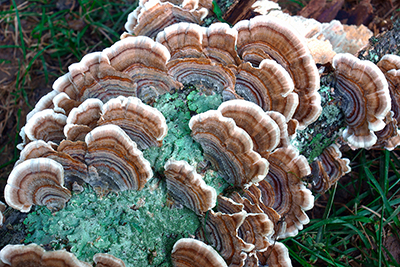 Turkey Tail (Coriolus versicolor)
Turkey Tail (Coriolus versicolor)
The active constituents in coriolus have been identified as proteoglycans with a β-1,4-glucan structure.[38], [39] Polysaccharides from coriolus have been shown to have an adjuvant effect when combined with other anticancer treatments including increasing NK-cell function as well as neutrophils and T-cell counts.[40], [41] Coriolus has mostly been used as an adjunct therapy in the treatment of lung, stomach, esophageal, colorectal, and breast cancers.[42], [43]
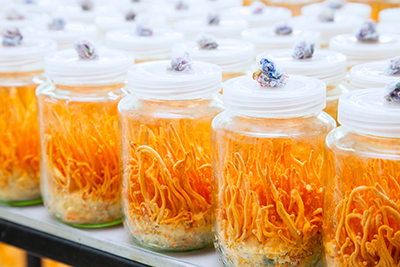 Cordyceps
Cordyceps
Also known as caterpillar fungus, wild cordyceps (Cordyceps sinensis) is not found growing on trees as its fellow fungi are, but it is rather found growing on an insect host.[44] Nowadays, they come from farms growing similar species like Cordyceps militaris or Paecilomyces hepiali. The active constituents in cordyceps include β-1,3-glucan and β-1,6-glucan.[45] Cordyceps plays a role in increasing several immune-cell types including helper T cells and NK cells.[46] Thus far, cordyceps’ strongest immune effect comes in the form of increasing lifespan in patients with liver cancer.[47]
When it comes to selecting a medicinal-mushroom product, there are two key considerations that we have reviewed. First is whether your mushrooms have been prepared as a hot-water extraction so that you can garner the greatest immune-enhancing effects of these fantastic fungi. Second is what species of medicinal mushroom to use—which ultimately boils down (pun intended) to the desired immune outcome you seek which, of course, should be discussed with your health-care practitioner.
 Dr. Colleen Hartwick, ND
Dr. Colleen Hartwick, ND
Dr. Colleen Hartwick is a licensed naturopathic physician practising on North Vancouver Island, BC, with a special interest in trauma as it plays a role in disease.
campbellrivernaturopathic.com
[1] Zhang, D., ed. Glycans and glycosaminoglycans as clinical biomarkers and therapeutics - Part B. Progress in Molecular Biology and Translational Science 163. Cambridge: Academic Press, 2019.
[2] Stengler, M. Health benefits of medicinal mushrooms. North Bergen: Basic Health Publications, 2005.
[3] Stengler. Health benefits of medicinal mushrooms.
[4] Stengler. Health benefits of medicinal mushrooms.
[5] Nisar, J., I. Mustafa, H. Anwar, M.U. Sohail, G. Hussain, M.I. Ullah, M.N. Faisal, S.A. Bukhari, and A. Basit. “Shiitake culinary-medicinal mushroom, Lentinus edodes (Agaricomycetes): A species with antioxidant, immunomodulatory, and hepatoprotective activities in hypercholesterolemic rats.” International Journal of Medicinal Mushrooms, Vol 19, No. 11 (2017): 981–990.
[6] Rop, O., J. Mlcek, and T. Jurikova. “Beta-glucans higher in fungi and their health effects.” Nutrition Reviews, Vol. 67, No. 11 (2009): 624–631.
[7] Gordon, M., B. Bihari, E. Goosby, R. Gorter, M. Greco, M. Guralnik, T. Mimura, V. Rudinicki, R. Wong, and Y. Kaneko. “A placebo-controlled trial of the immune modulator, lentinan, in HIV-positive patients: A phase I/II trial.” Journal of Medicine, Vol. 29, No. 5–6 (1998): 305–330.
[8] Fang, N., Q. Li, S. Yu, J. Zhang, L. He, M.J.J. Ronis, and T.M. Badger. “Inhibition of growth and induction of apoptosis in human cancer cell lines by an ethyl acetate fraction from shiitake mushrooms.” Journal of Alternative and Complementary Medicine, Vol. 12, No. 2 (2006): 125–32.
[9] Dai, X., J.M. Stanilka, C.A. Rowe, E.A. Esteves, C. Nieves Jr, S.J. Spaiser, M.C. Christman, B. Langkamp-Henken, and S.S. Percival. “Consuming Lentinula edodes (shiitake) mushrooms daily improves human immunity: A randomized dietary intervention in healthy young adults.” Journal of the American College of Nutrition, Vol. 34, No. 6 (2015): 478–487.
[10] Nisar et al. “Shiitake culinary-medicinal mushroom.”
[11] Kodama, N., N. Harada, and H. Nanba. “A polysaccharide, extract from Grifola frondosa, induces Th-1 dominant responses in carcinoma-bearing BALB/c mice.” Japanese Journal of Pharmacology, Vol. 90, No. 4 (2002): 357–360.
[12] Kodama, N., K. Komuta, and H. Nanba. “Effect of maitake (Grifola frondosa) D-fraction on the activation of NK cells in cancer patients.” Journal of Medicinal Food, Vol. 6, No. 4 (2003): 371–377.
[13] Takeyama, T., I. Suzuki, N. Ohno, S. Oikawa, K. Sato, M. Ohsawa, and T. Yadomae. “Host-mediated antitumor effect of grifolan NMF-5N, a polysaccharide obtained from Grifola frondosa.” Journal of Pharmacobio-Dynamics, Vol. 10, No. 11 (1987): 644–651.
[14] Suzuki, I., T. Itani, N. Ohno, S. Oikawa, K. Sato, T. Miyazaki, and T. Yadomae. “Effect of a polysaccharide fraction from Grifola frondosa on immune response in mice.” Journal of Pharmacobio-Dynamics, Vol. 8, No. 3 (1985): 217–226.
[15] Kodama, Komuta, and Nanba. “Effect of maitake (Grifola frondosa) D-fraction.”
[16] Fullerton, S.A., A.A. Samadi, D.G. Tortorelis, M.S. Choudhury, C. Mallouh, H. Tazai, and S. Konno. “Induction of apoptosis in human prostatic cancer cells with beta-glucan (maitake mushroom polysaccharide).” Molecular Urology, Vol. 4, No. 1 (2000): 7–13.
[17] Nanba, H., N. Kodama, D. Schar, and D. Turner. “Effects of maitake (Grifola frondosa) glucan in HIV-infected patients.” Mycoscience, Vol. 41, No. 4 (2000): 293–295.
[18] Kim, Y.-R. “Immunomodulatory activity of the water extract from medicinal mushroom Inonotus obliquus.” Mycobiology, Vol. 33, No. 3 (2005): 158–162.
[19] Kim. “Immunomodulatory activity of the water extract.”
[20] Kim. “Immunomodulatory activity of the water extract.”
[21] Polovnikova, M.V., N.N. Nosik, T.M. Garaev, N.G. Kondrashina, M.P. Finogenova, and V.A. Shibnev. “[A study of the antiherpetic activity of the chaga mushroom (Inonotus obliquus) extracts in the Vero cells infected with the herpes simplex virus]” (article in Russian). Voprosy Virusologii, Vol. 59, No. 2 (2014): 45–48.
[22] Pan, H.-H., X.-T. Yu, T. Li, H.-L. Wu, C.-W. Jiao, M.-H. Cai, X.-M. Li, Y.-Z. Xie, Y. Wang, and T. Peng. “Aqueous extract from a chaga medicinal mushroom, Inonotus obliquus (higher basidiomyetes), prevents herpes simplex virus entry through inhibition of viral-induced membrane fusion.” International Journal of Medicinal Mushrooms, Vol. 15, No. 1 (2013): 29–38.
[23] Martin, D.E., R. Blum, J. Doto, H. Galbraith, and C. Ballow. “Multiple-dose pharmacokinetics and safety of bevirimat, a novel inhibitor of HIV maturation, in healthy volunteers.” Clinical Pharmacokinetics, Vol. 46, No. 7 (2007): 589–598.
[24] Smith, P.F., A. Ogundele, A. Forrest, J. Wilton, K. Salzwedel, J. Doto, G.P. Allaway, and D.E. Martin. “Phase I and II study of the safety, virologic effect, and pharmacokinetics/pharmacodynamics of single-dose 3-O-(3′,3′-dimethylsuccinyl)-betulinic acid (bevirimat) against human immunodeficiency virus infection.” Antimicrobial Agents and Chemotherapy, Vol. 51, No. 10 (2007): 3574–3581.
[25] Chintharlapalli, S., S. Papineni, P. Lei, S. Pathi, and S. Safe. “Betulinic acid inhibits colon cancer cell and tumor growth and induces proteasome-dependent and -independent downregulation of specificity proteins (Sp) transcription factors.” BMC Cancer, Vol. 11 (2011): 371.
[26] Damle, A.A., Y.P. Pawar, and A.A. Narkar. “Anticancer activity of betulinic acid on MCF-7 tumors in nude mice.” Indian Journal of Experimental Biology, Vol. 51, No. 7 (2013): 485–491.
[27] Lemieszek, M.K., E. Langner, J. Kaczor, M. Kandefer-Szerszeń, B. Sanecka, W. Mazurkiewicz, and W. Rzeski. “Anticancer effects of fraction isolated from fruiting bodies of chaga medicinal mushroom, Inonotus obliquus (Pers.:Fr.) Pilát (Aphyllophoromycetideae): In vitro studies.” International Journal of Medicinal Mushrooms, Vol. 13, No. 2 (2011): 131–143.
[28] Mertens-Talcott, S.U., G.D. Noratto, X. Li, G. Angel-Morales, M.C. Bertoldi, and S. Safe. “Betulinic acid decreases ER-negative breast cancer cell growth in vitro and in vivo: Role of Sp transcription factors and microRNA-27a:ZBTB10.” Molecular Carcinogenesis, Vol. 52, No. 8 (2013): 591–602.
[29] Mullauer, F.B., L. van Bloois, J.B. Daalhuisen, M.S. Ten Brink, G. Storm, J.P. Medema, R.M. Schiffelers, and J.H. Kessler. “Betulinic acid delivered in liposomes reduces growth of human lung and colon cancers in mice without causing systemic toxicity.” Anti-Cancer Drugs, Vol. 22, No. 3 (2011): 223–233.
[30] Powell, M. Medicinal mushrooms: A clinical guide. East Sussex: Mycology Press, 2010.
[31] Gao, Y., S. Zhou, W. Jiang, M. Huang, and X. Dai. “Effects of Ganopoly® (a Ganoderma lucidum polysaccharide extract) on the immune functions in advanced‐stage cancer patients.” Immunological Investigations, Vol. 32, No. 3 (2003): 201–215.
[32] Zhuang, S. -R., H.F. Chiu, S.-L. Chen, J.-H. Tsai, M.Y. Lee, H.-S. Lee, Y.C. Shen, Y.Y. Yan, G.T. Shane, and C.-K. Wang. “Effects of a Chinese medical herbs complex on cellular immunity and toxicity-related conditions of breast cancer patients.” The British Journal of Nutrition, Vol. 107, No. 5 (2012): 712–718.
[33] Zhuang, S.-R., S.-L. Chen, J.-H. Tsai, C.-C. Huang, T.-C. Wu, W.-S. Liu, H.-C. Tseng, et al. “Effect of citronellol and the Chinese medical herb complex on cellular immunity of cancer patients receiving chemotherapy/radiotherapy.” Phytotherapy Research, Vol. 23, No. 6 (2009): 785–790.
[34] Chen, X., Z.-P. Hu, X.-X. Yang, M. Huang, Y. Gao, W. Tang, S.Y. Chan, et al. “Monitoring of immune responses to a herbal immuno-modulator in patients with advanced colorectal cancer.” International Immunopharmacology, Vol. 6, No. 3 (2006): 499–508.
[35] Gao, Y., W. Tang, X. Dai, H. Gao, G. Chen, J. Ye, E. Chan, H.L. Koh, X. Li, and S. Zhou. “Effects of water-soluble Ganoderma lucidum polysaccharides on the immune functions of patients with advanced lung cancer.” Journal of Medicinal Food, Vol. 8, No. 2 (2005): 159–168.
[36] Oka, S., S. Tanaka, S. Yoshida, T. Hiyama, Y. Ueno, M. Ito, Y. Kitadai, M. Yoshihara, and K. Chayama. “A water-soluble extract from culture medium of Ganoderma lucidum mycelia suppresses the development of colorectal adenomas.” Hiroshima Journal of Medical Sciences, Vol. 59, No. 1 (2010): 1–6.
[37] Hijikata, Y., S. Yamada, and A. Yasuhara. “Herbal mixtures containing the mushroom Ganoderma lucidum improve recovery time in patients with herpes genitalis and labialis.” Journal of Alternative and Complementary Medicine, Vol. 13, No. 9 (2007): 985–987.
[38] Kidd, P.M. “The use of mushroom glucans and proteoglycans in cancer treatment.” Alternative Medicine Review, Vol. 5, No. 1 (2000): 4–27.
[39] [Anonymous.] “Coriolus versicolor.” Memorial Sloan Kettering Cancer Center. · https://www.mskcc.org/cancer-care/integrative-medicine/herbs/coriolus-versicolor · Updated 2021-03-04.
[40] Fritz, H. Coriolus versicolor and lung cancer: A systematic review. Society of Integrative Oncology (SIO) Conference, Cleveland, Ohio, 2011 (oral presentation).
[41] Ohwada, S., T. Ogawa, F. Makita, Y. Tanahashi, T. Ohya, N. Tomizawa, Y. Satoh, et al. “Beneficial effects of protein-bound polysaccharide K plus tegafur/uracil in patients with stage II or III colorectal cancer: Analysis of immunological parameters.” Oncology Reports, Vol. 15, No. 4 (2006): 861–868.
[42] Kidd. “The use of mushroom glucans.”
[43] [Anonymous.] “Coriolus versicolor.” Memorial Sloan Kettering Cancer Center. · https://www.mskcc.org/cancer-care/integrative-medicine/herbs/coriolus-versicolor · Updated 2021-03-04.
[44] Powell. Medicinal mushrooms.
[45] [Anonymous.] “Cordyceps.” Memorial Sloan Kettering Cancer Center. · http://www.mskcc.org/cancer-care/herb/cordyceps · Updated 2020-08-13.
[46] Zhu, J.S., G.M. Halpern, and K. Jones. “The scientific rediscovery of a precious ancient Chinese herbal regimen: Cordyceps sinensis: Part II.” Journal of Alternative and Complementary Medicine, Vol. 4, No. 4 (1998): 429–457.
[47] Niwa, Y., H. Matsuura, M. Murakami, J. Sato, K. Hirai, and H. Sumi. “Evidence that naturopathic therapy including Cordyceps sinensis prolongs survival of patients with hepatocellular carcinoma.” Integrative Cancer Therapies, Vol. 12, No. 1 (2013): 50–68.

 Stores
Stores
